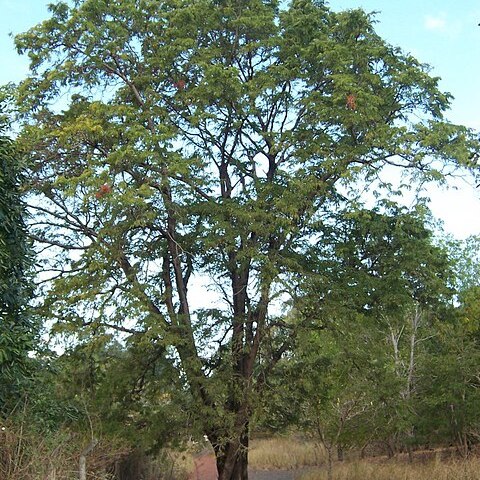Trees. Leaves abruptly pinnate, alternate; stipules caducous, small; leaflets 10 to numerous paired. Racemes or racemes arranged in panicles at ends of shoots; bracts and bracteoles often caducous, colored, ovate-oblong. Calyx tube narrowly turbinate; segments 4, imbricate. Petals: only upper 3 developed, subequal in length, lower 2 reduced, scalelike, concealed at base of staminal tube. Perfect stamens 3, connate into an ascending, curved tube or sheath from middle downward; filaments short; anthers dorsifixed; staminodes few, minute, at apex of sheath. Ovary stalked, stalk adnate to calyx tube; ovules numerous; style elongated; stigma capitate. Legume narrowly terete, indehiscent; epicarp thin, crustaceous; mesocarp thick and pulpy; endocarp membranous, septate between seeds. Seeds compressed, obliquely oblong or obliquely ovoid-orbicular; cotyledons thick, fleshy; embryo erect.
Unarmed, evergreen tree. Leaves paripinnate; stipules free, deciduous; leaflets opposite, subsessile, asymmetric basally. Flowers in lax, terminal and lateral racemes; bracteoles 2, valvate, enclosing the young flower buds but deciduous before the buds mature. Hypanthium shortly elongate-turbinate. Sepals 4, imbricate. Petals: upper 3 well-developed; lower 2 minute, setiform, below the staminal tube. Staminal filaments united to about halfway into a tube terminating in 3 upcurved anther-bearing filaments alternating with 5 sterile teeth (1 or 2 teeth rarely elongated into short filaments). Ovary stipitate; stipe adnate to one side of the hypanthium; style gradually enlarged into the capitate stigma. Pod compressed, indehiscent, with a dry outer shell and a pulpy inner layer. Seeds ±compressed, each face with a continuous-margined areole.
Medium-sized trees of lower elevations. Leaves evenly pinnate, moderate-sized, short-petiolate; stipules minute, caducous; leaflets small, numerous, sessile, paired. Inflorescence short, usually terminal, few-flowered, racemose. Flowers moderately large, attractive; calyx 4-parted, the lobes reflexed above the receptacular base, imbricate in bud; petals very unequal, the 3 uppermost expanded and the 2 lower-most rudimentary; stamens 3, monadelphous; staminodia minute; anthers long i-tudinally dehiscent; ovary stipitate, the stipe adnate to the receptacular tube; style elongate, with a terminal subcapitate stigma. Legume linear-oblong, curved, thick, indehiscent, septate between the obovate-orbicular seeds.
Leaves paripinnate; leaflets opposite, in rather numerous pairs, almost sessile, asymmetric at base, with 1–2 secondary nerves from base on the proximal side of main nerve; translucent gland-dots absent; stipules free, asymmetrically lanceolate, very early caducous.
Ovary ± pubescent, long-stipitate, with the stipe adnate to one side of the hypanthium; ovules 8–14; style elongate, gradually enlarged into the stigma.
Stamen-filaments connate to about half-way into a pubescent band terminating in 3 upcurved anther-bearing filaments alternating with 5 sterile teeth.
Flowers in lax terminal and axillary racemes; bracteoles 2, well developed, valvate, completely enclosing the young flower buds but early caducous.
Pod cylindrical with irregular constrictions, indehiscent, with a dry outer shell and pulpy inner layer.
Seeds ± compressed, with a continuous-margined areole on each face.
Upper 3 petals well developed, lower 2 minute, setiform.
Tree, evergreen or semi-deciduous, unarmed.
Hypanthium shortly elongate-turbinate.
Sepals 4, imbricate.

